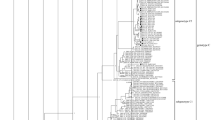Abstract
Although human echovirus 25 (E-25), a type of the enterovirus B species, is implicated in aseptic meningitis, information on its gene structure, evolution, and virulence are limited. We report here the complete genome sequence of a novel recombinant E-25 strain (E25/2010/CHN/BJ) isolated from a neonate with hand, foot, and mouth disease complicated by encephalitis in Beijing, China in 2010. The complete viral genome consists of 7429 nucleotides (nts), including a 6585-nt open reading frame. Phylogenetic dendrogram based on VP1 gene regions revealed that this strain belonged to subgroup D4, which contains the other E-25 strains isolated from China in recent years. The difference in the amino acid sites (P130S, K/T135I) of the VP1 region may affect its immunogenicity. SimPlot and Bootscan analyses suggested that E25/2010/CHN/BJ is a recombination result of E-25 and Coxsackievirus B3 (CVB-3) strains. Our results would facilitate the study of the origin, evolution, and molecular epidemiology of E-25.

Similar content being viewed by others
References
D. Kiang, E.C. Newbower, E. Yeh, L. Wold, L. Chen, D.P. Schnurr, An algorithm for the typing of enteroviruses and correlation to serotyping by viral neutralization. J. Clin. Virol. 45, 334 (2009)
M.B. Guidotti, An outbreak of skin rash by echovirus 25 in an infant home. J. Infect. 6, 67 (1983)
A.E. Kelen, J.M. Lesiak, N.A. Labzoffsky, An outbreak of aseptic meningitis due to ECHO 25 virus. Can. Med. Assoc. J. 90, 1349 (1964)
A.C. Peters, G.J. Vielvoye, J. Versteeg, G.T. Bots, J. Lindeman, ECHO 25 focal encephalitis and subacute hemichorea. Neurology 29, 676 (1979)
J.A. Roberts, K.A. Grant, Y.K. Yoon, S. Polychronopoulos, A. Ibrahim, B.R. Thorley, Annual report of the Australian National Poliovirus Reference Laboratory, 2008. Commun. Dis. Intell. Q. Rep. 33, 291 (2009)
E.J. Bell, N.R. Grist, Echovirus 25 infections in Scotland, 1961-64. Lancet 2, 464 (1965)
M. Clementi, Meningitis caused by echovirus 25. Minerva Med. 69, 3941 (1978)
U. Kunkel, E. Schreier, Characterization of echovirus 25 (ECV 25) in the VP1/2A gene junction region. Brief report. Arch. Virol. 144, 2253 (1999)
S.G.P. Dos, I. Skraba, D. Oliveira, A.A. Lima, M.M. de Melo, C.I. Kmetzsch, E.V. da Costa, E.E. da Silva, Enterovirus meningitis in Brazil, 1998-2003. J. Med. Virol. 78, 98 (2006)
A.C. Nielsen, B. Bottiger, S.E. Midgley, L.P. Nielsen, A novel enterovirus and parechovirus multiplex one-step real-time PCR-validation and clinical experience. J. Virol. Methods 193, 359 (2013)
G. Papadakis, D. Chibo, J. Druce, M. Catton, C. Birch, Detection and genotyping of enteroviruses in cerebrospinal fluid in patients in Victoria, Australia, 2007-2013. J. Med. Virol. 86, 1609 (2014)
T.H. Han, J.Y. Chung, S.J. You, J.L. Youn, G.H. Shim, Human parechovirus-3 infection in children, South Korea. J. Clin. Virol. 58, 194 (2013)
T. Zhang, J. Du, Y. Xue, H. Su, F. Yang, Q. Jin, Epidemics and frequent recombination within species in outbreaks of human enterovirus B-associated hand, foot and mouth disease in Shandong China in 2010 and 2011. PLoS ONE 8, e67157 (2013)
L. Chao, X.Y. Huang, X.L. Li, B.L. Xu, Genetic characterization of echovirus 25 isolated from Henan. Bing Du Xue Bao. 26, 443 (2010)
T. Bingjun, H. Yoshida, W. Yan, L. Lin, T. Tsuji, H. Shimizu, T. Miyamura, Molecular typing and epidemiology of non-polio enteroviruses isolated from Yunnan Province, the People’s Republic of China. J. Med. Virol. 80, 670 (2008)
W.K. De Changwen, L. Wei, C. Monagin, Y. Jin, M. Cong, Z. Hanri, S. Jun, A large outbreak of hand, foot, and mouth disease caused by EV71 and CAV16 in Guangdong, China, 2009. Arch. Virol. 156, 945 (2011)
T. Solomon, P. Lewthwaite, D. Perera, M.J. Cardosa, P. McMinn, M.H. Ooi, Virology, epidemiology, pathogenesis, and control of enterovirus 71. Lancet. Infect. Dis. 10, 778 (2010)
D. Nasri, L. Bouslama, S. Pillet, T. Bourlet, M. Aouni, B. Pozzetto, Basic rationale, current methods and future directions for molecular typing of human enterovirus. Expert. Rev. Mol. Diagn. 7, 419 (2007)
M.S. Oberste, K. Maher, A.J. Williams, N. Dybdahl-Sissoko, B.A. Brown, M.S. Gookin, S. Penaranda, N. Mishrik, M. Uddin, M.A. Pallansch, Species-specific RT-PCR amplification of human enteroviruses: a tool for rapid species identification of uncharacterized enteroviruses. J. Gen. Virol. 87, 119 (2006)
V. Caro, S. Guillot, F. Delpeyroux, R. Crainic, Molecular strategy for ‘serotyping’ of human enteroviruses. J. Gen. Virol. 82, 79 (2001)
M.S. Oberste, K. Maher, D.R. Kilpatrick, M.R. Flemister, B.A. Brown, M.A. Pallansch, Typing of human enteroviruses by partial sequencing of VP1. J. Clin. Microbiol. 37, 1288 (1999)
B. Sherry, A.G. Mosser, R.J. Colonno, R.R. Rueckert, Use of monoclonal antibodies to identify four neutralization immunogens on a common cold picornavirus, human rhinovirus 14. J. Virol. 57, 246 (1986)
M.S. Oberste, K. Maher, M.A. Pallansch, Evidence for frequent recombination within species human enterovirus B based on complete genomic sequences of all thirty-seven serotypes. J. Virol. 78, 855 (2004)
P. Simmonds, J. Welch, Frequency and dynamics of recombination within different species of human enteroviruses. J. Virol. 80, 483 (2006)
Acknowledgments
This work was supported by a grant from the Science and Technology Project of Beijing, China (No. D131100005313016). Support was also provided by Collaborative Innovation Center of Infectious Diseases and Beijing Key Laboratory of Emerging Infectious Diseases, Beijing, China.
Author information
Authors and Affiliations
Corresponding authors
Additional information
Edited by Paul Schnitzler.
Hongjie Li and Yixing Meng have contributed equally to this work.
Electronic supplementary material
Below is the link to the electronic supplementary material.
Rights and permissions
About this article
Cite this article
Li, H., Meng, Y., Pang, L. et al. Complete genome sequence of a new recombinant echovirus 25 strain isolated from a neonatal patient with hand, foot, and mouth disease complicated by encephalitis in Beijing, China. Virus Genes 50, 505–508 (2015). https://doi.org/10.1007/s11262-015-1186-9
Received:
Accepted:
Published:
Issue Date:
DOI: https://doi.org/10.1007/s11262-015-1186-9




